#eulogio de córdoba
Text
9th part of the bookscans of Al Andalus. Historical Figures, here's the previous part
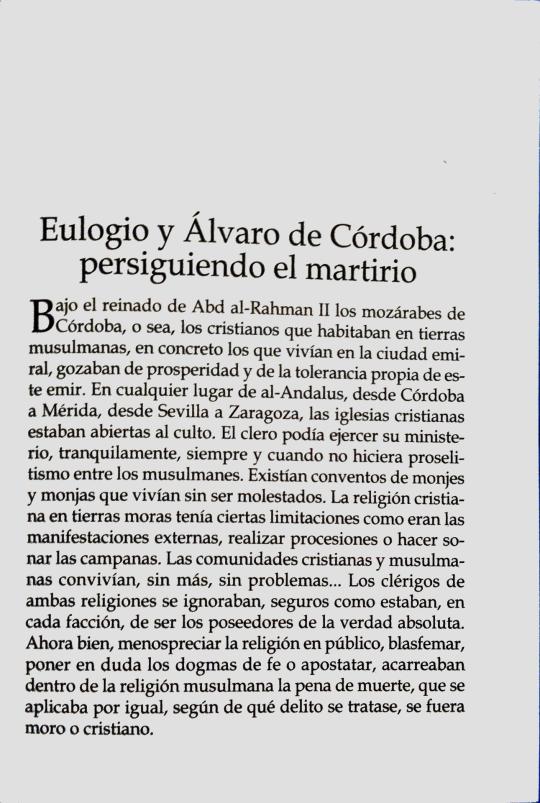
Eulogio and Álvaro de Córdoba:
pursuing martyrdom
Under the reign of Abd al-Rahman II the Mozarabs of Córdoba, that is, the
Christians who lived in Muslim lands, specifically those who lived in the emiral city, enjoyed prosperity and the tolerance typical of this emir. Anywhere in al-Andalus, from Córdoba to Mérida, from Seville to Zaragoza, the Christian churches were open for worship. The clergy could exercise his ministry, quietly, as long as he did not proselytize among the Muslims. There were convents of monks and nuns who lived without being bothered The Christian religion in Moorish lands had certain limitations such as the external manifestations, carrying out processions or ringing the bells. The Christian and Muslim communities lived together, without further ado, without problems... The clerics of both religions ignored each other, sure as were, in each faction, to be the possessors of the absolute truth. Now
well, belittling religion in public, blaspheming, questioning dogmas
of faith or apostatizing, carried within the Muslim religion the penalty of death, which was applied equally, depending on what crime it was, whether if the person was Moor or Christian.
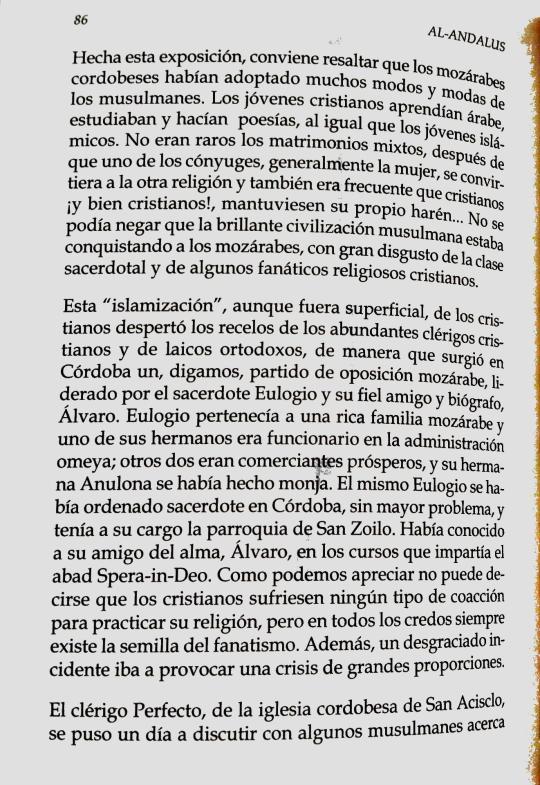
Having made this exposition, it is worth highlighting that the Mozarabs of Cordoba
had adopted many ways and fashions of the Muslims. Young Christians learned Arabic, studied and wrote poetry, just like the Islamic youth. Mixed marriages were not uncommon, after one of the spouses, usually the woman, converts to the other religion and it was also common for Christians, and very Christians, to maintain their own harem... It could not be denied that the brilliant Muslim civilization
was conquering the Mozarabs, to the great displeasure of the priesthood class and some Christian religious fanatics.
This "Islamization", even if it was superficial, of the Christians aroused the
suspicions of the abundant Christian clerics and Orthodox laymen, of way that a, let's say, Mozarabic opposition party emerged in Córdoba, led by the priest Eulogio and his faithful friend and biographer, Álvaro. Eulogio belonged to a rich Mozarabic family and one of his brothers was official in the Umayyad administration; two others were merchants
prosperous, and his sister Anulona had become a nun. Eulogius himself
had been ordained a priest in Córdoba, without much problem, and had his
charge of the parish of San Zoilo. He had met his soul friend, Alvaro in the courses taught by Abbot Spera-in-Deo. As we can see, It can be not said that Christians suffered type of coercion to practice their religion, but in all faiths there is always the seed of fanaticism. Furthermore, an unfortunate incident was going to cause a crisis of great proportions.
The clergyman Perfecto, from the Cordoban church of San Acisclo, one day began to argue with some Muslims about
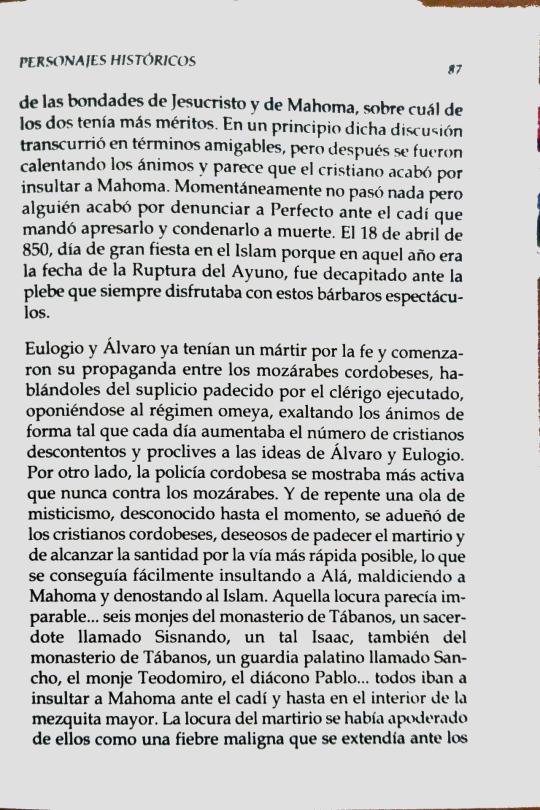
of the goodness of Jesus Christ and Muhammad, about which of the two had more merits. At first the discussion was on friendly terms, but later tempers were heating up and it seems that the Christian ended up insulting Muhammad. Momentarily nothing happened but someone ended up reporting Perfecto to the the cadi who ordered him to be arrested and sentenced to death. On April 18, 850, day of great holiday in Islam because that year was the date of the Breaking of the Fast, it was beheaded before the plebs who always enjoyed these barbaric spectacles.
Eulogio and Álvaro already had a martyr for the faith and began their propaganda among the Mozarabs of Cordoba, telling them about the torture suffered by the clergyman executed, opposing the Umayyad regime, raising spirits in such a way that every day the number of discontented Christians inclined to the ideas of Álvaro and Eulogio. On the other hand, the Córdoba police were more active than never against the Mozarabs. And suddenly a wave of mysticism, unknown until moment, took over the Christians of Cordoba, eager to suffer the martyrdom and achieving sainthood in the quickest way possible, which was achieved
easily insulting Allah, cursing Muhammad and reviling Islam. That madness seemed unstoppable...six monks from the Tábanos monastery, a priest named Sisnando, a certain Isaac, also from the Tábanos monastery, a guard palatine named Sancho, the monk Teodomiro, the deacon Pablo... they all went to insulting Muhammad before the qadi and even inside the main mosque. The madness
of martyrdom had taken hold of them like a malignant fever that spread before the
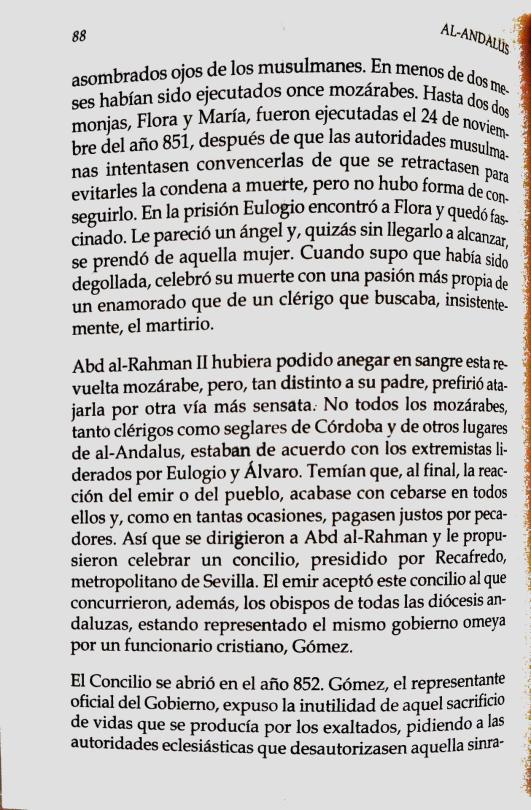
amazed eyes of the Muslims. In less than two months they had been eleven Mozarabs executed. Even two nuns, Flora and María, were executed on November 24, 851, after the Muslim authorities tried to convince them to recant to avoid the death sentence, but there was no way to achieve it. In prison Eulogio found Flora and was fascinated. It seemed like a
angel and, perhaps without reaching him, he fell in love with that woman. When
knew that she had been beheaded, he celebrated her death with a greater passion typical of a lover than of a clergyman who was insistently seeking,
the martyrdom.
Abd al-Rahman II could have drowned this revolt in Mozarabic blood, but, so different from his father, he preferred to tackle it by another sensiblebway. Not all the Mozarabs, both clerics and laymen of Córdoba and from other places in al-Andalus, agreed with the extremists
led by Eulogio and Álvaro. They feared that, in the end, the emir's reaction
or the town, ended up attacking all of them and, as in so many sometimes, the righteous paid for sinners. So they approached Abd al-Rahman and proposed holding a council, presided over by
Recafredo, metropolitan of Seville. The emir accepted this council to which, in addition, the bishops of all the Andalusian dioceses attended, the Umayyad government itself being represented by a Christian official, Gómez.
The Council opened in the year 852. Gómez, the official representative of the
Government, exposed the futility of that sacrifice of lives that occurred
by the exalted, asking the ecclesiastical authorities to disavow that non-
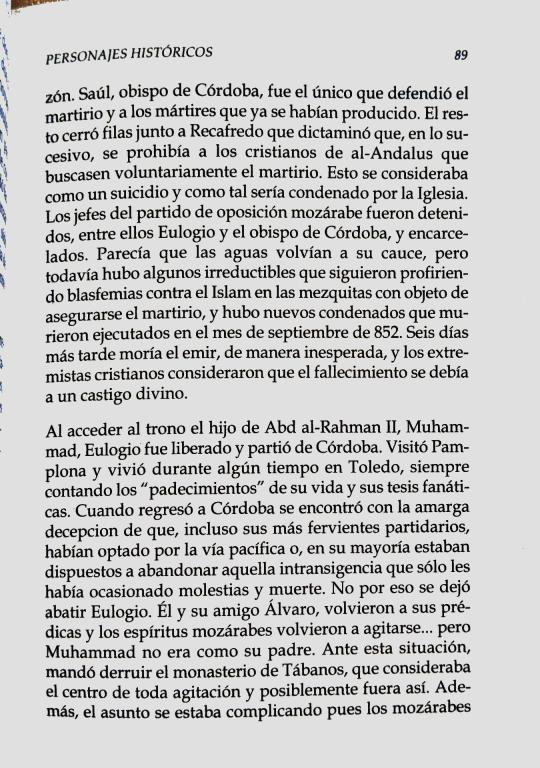
sense. Saúl, bishop of Córdoba, was the only one who defended martyrdom and the martyrs that had already occurred. The rest closed ranks with Recafredo who
ruled that, from now on, the Christians of al-Andalus were prohibited from
voluntarily seek martyrdom. This was considered suicide and
as such he would be condemned by the Church. The leaders of the Mozarabic opposition party were arrested, among them Eulogio and the bishop of Córdoba, and imprisoned. It seemed that the waters were returning to their channel, but there was still some irreducibles who continued uttering blasphemies against Islam in the
mosques in order to ensure martyrdom, and there were new convicts who were executed in the month of September 852. Six days later the emir died, unexpectedly, and the Christian extremists considered that the death was due to divine punishment.
When Abd al-Rahman II's son, Muhammad, acceded to the throne, Eulogius was released and left Córdoba. He visited Pamplona and lived for some time in Toledo, always recounting the "sufferings" of his life and his fanatical theses. When he returned to Córdoba he was met with the bitter disappointment that, even his most fervent supporters had opted for the peaceful route or, for the most part, were willing to abandon that intransigence that had only caused inconvenience and death. That's not why Eulogio let himself be discouraged. Him and his friend Álvaro, they returned to their preachings and the Mozarabic spirits stirred again... but Muhammad was not like his father. Faced with this situation, he ordered the demolition of the Tábanos monastery, which he considered the center of all unrest and possibly it was like that. Furthermore, the matter was becoming complicated because the Toledoan
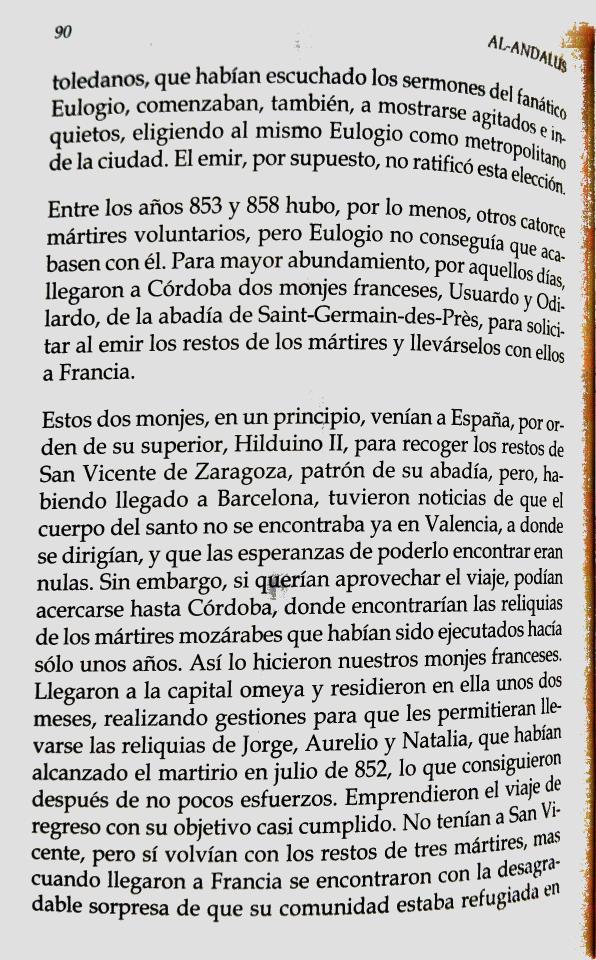
Mozarabs who had listened to the sermons of the fanatic Eulogio, were also beginning to appear agitated and restless, choosing Eulogio as metropolitan of the city. The emir, of course, did not ratified this election.
Between the years 853 and 858 there were at least fourteen other martyrs volunteers, but Eulogio couldn't get them to finish him off. For more abundance, in those days, two French monks arrived in Córdoba,
Usuard and Odilard, from the abbey of Saint-Germain-des-Près, to request the remains of the martyrs from the emir and take them with them to France.
These two monks, at first, came to Spain, by order of their superior, Hildouin II, to collect the remains of S. Vicente de Zaragoza, patron of his abbey, but, having arrived in Barcelona, they had news
that the saint's body was no longer in Valencia, where it was led, and that the hopes of being able to find him were zero.
However, if they wanted to take advantage of the trip, they could go to Córdoba,
where they found the relics of the Mozarabic martyrs who had been
executed only a few years ago. This is what our French monks did. They arrived in the Umayyad capital and lived there for about two months, taking steps to allow them to take the relics of Jorge, Aurelio and Natalia, who had achieved martyrdom in July 852, what they achieved after quite a bit of effort. They started the journey
back with his goal almost accomplished. They did not have S. Vicente, but they did returned with the remains of three martyrs, but when they arrived in France they found themselves with the unpleasant surprise that their community was
refugee in
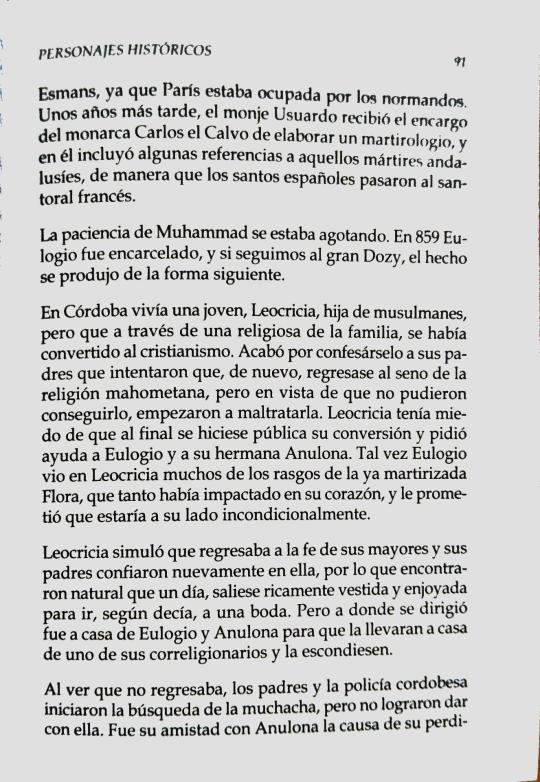
Esmans, since Paris was occupied by the Normans. A few years later, the monk Usuard received the commission from the monarch Charles the Bald to prepare a
martyrology, and in it he included some references to those Andalusian martyrs,
so that the Spanish saints passed to the French saints.
Muhammad's patience was wearing thin. In 859 Eulogio was imprisoned, and if we follow the great Dozy, the event occurred in the following way.
In Córdoba there lived a young woman, Leocricia, daughter of Muslims, but through a nun in the family, had converted to Christianity. She ended up confessing it to his parents who tried to get her to return to the bosom of the Mohammedan religion, but since they could not obtain it,
they began to mistreat her. Leocricia was afraid that in the end her conversion would become public and asked Eulogio and his sister Anulona for help. Maybe Eulogio saw
in Leocricia many of the traits of the already martyred Flora, who had so much
shocked in his heart, and he promised that he would be by his side unconditionally.
Leocricia pretended to return to the faith of her elders and her parents trusted
again in it, so they found it natural that one day, it would come out richly dressed and jeweled to go, as she said, to a wedding. But where she went to Eulogio and Anulona's house so they could take her to the house of one of her coreligionists and hid her.
Seeing that she did not return, the parents and the Córdoba police began the search
of the girl, but they could not find her. It was his friendship with Anulona that
cause of her perdi-
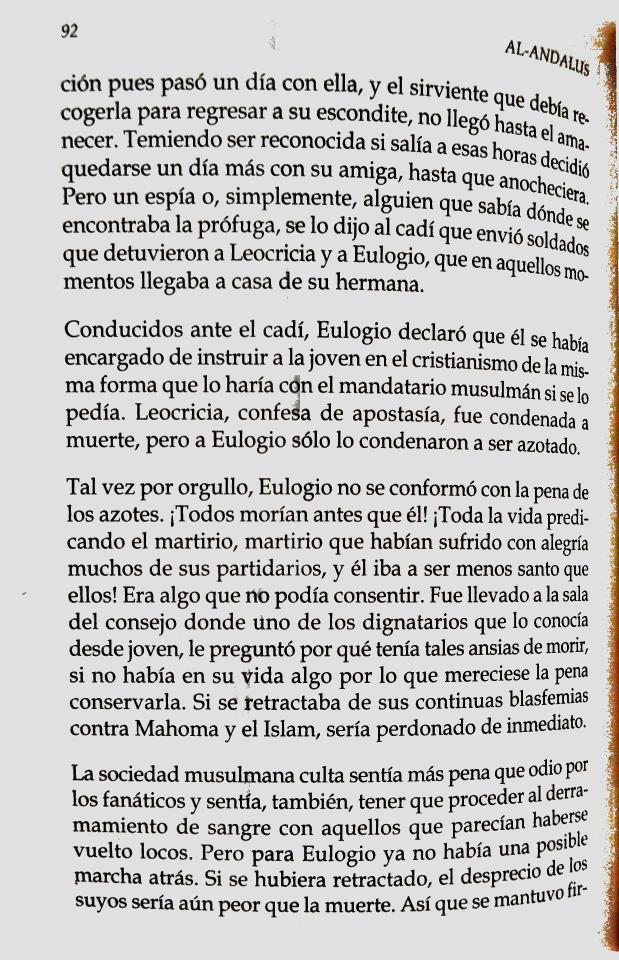
tion because she spent a day with her, and the servant who was to pick her up to
return to her hiding place, she did not arrive until dawn. Fearing to be recognized if she went out at that time, she decided to stay one more day with her friend, until nightfall. But a spy or simply someone who knew where the fugitive was, told the cadi who sent soldiers to arrest Leocricia and Eulogio, who at that time was reaching
his sister's house.
Brought before the cadi, Eulogio declared that he had taken care of instruct the young woman in Christianity in the same way as he would with the Muslim leader if he asked. Leocricia, confessed of apostasy,
was sentenced to death, but Eulogio was only sentenced to be whipped.
Perhaps out of pride, Eulogio did not settle for the punishment of whipping. Everyone died before him! All his life preaching martyrdom, martyrdom that many of his supporters had suffered with joy, and he
I was going to be less holy than them! It was something he couldn't consent. He was taken to the council room where one of the dignitaries who knew him since he was young, he asked him why he had such a desire to die, if there was no something in his life worth keeping. If he retracted
of his continued blasphemies against Muhammad and Islam, he would be forgiven immediately.
The cultured Muslim society felt more pity than hatred for the fanatics and they also felt that they had to proceed to shed blood with those who seemed to have gone crazy. But for Eulogio there was no longer a possible retreat. If he had retracted, the contempt of his people would be even worse than death. So he stood firm
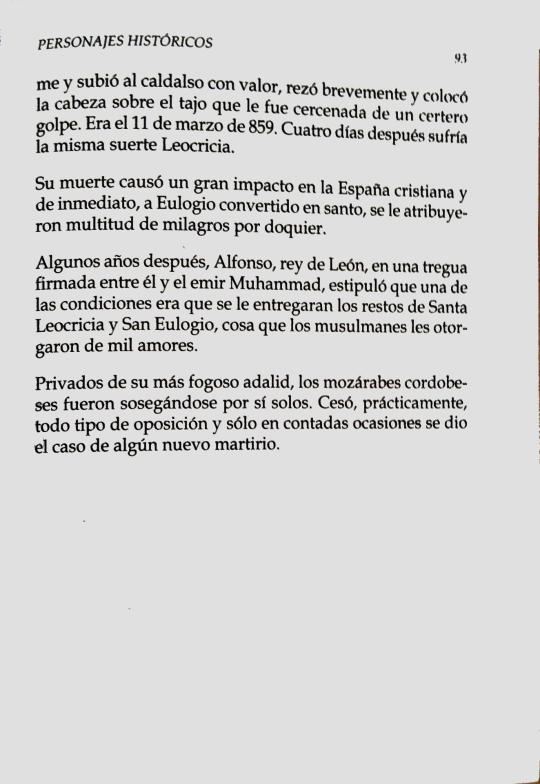
and he bravely climbed into the scaffold, prayed briefly and placed his head on the
slash that was severed with a well-aimed blow. It was March 11, 859. Four days later Leocricia suffered the same fate.
His death caused a great impact in Christian Spain and immediately,
Eulogio became a saint, a multitude of miracles were attributed to him
everywhere.
Some years later, Alfonso, king of León, in a truce signed between him and the emir Muhammad, stipulated that one of the conditions was that the remains of S. Leocricia and S. Eulogio would be handed over, something that Muslims gave them a thousand loves.
Deprived of their most fiery champion, the Mozarabs of Córdoba were calming down on their own. Practically all types of opposition ceased and only on rare occasions there was the case of a new martyrdom.
#al andalus. historical figures#al andalus. personajes históricos#al andalus#book scans#al andalus history#bookblr#historyblr#spanish history#emirate of cordoba#eulogio de córdoba#álvaro de córdoba#emirato de córdoba
15 notes
·
View notes
Text
San Isaac de Córdoba, mártir mozárabe
[Córdoba, c. 824 – m. Córdoba, 3 junio 851] Santo y mártir mozárabe.
Isaac era un joven mozárabe que se convirtió en el primero de los mártires de Córdoba, el movimiento cristiano que sacudió la Córdoba de mediados del siglo IX. Su historia nos ha sido transmitida por San Eulogio de Córdoba.
Isaac habría nacido en torno al año 824, pues el martirologio de Usuardo dice que tenía veintisiete años…
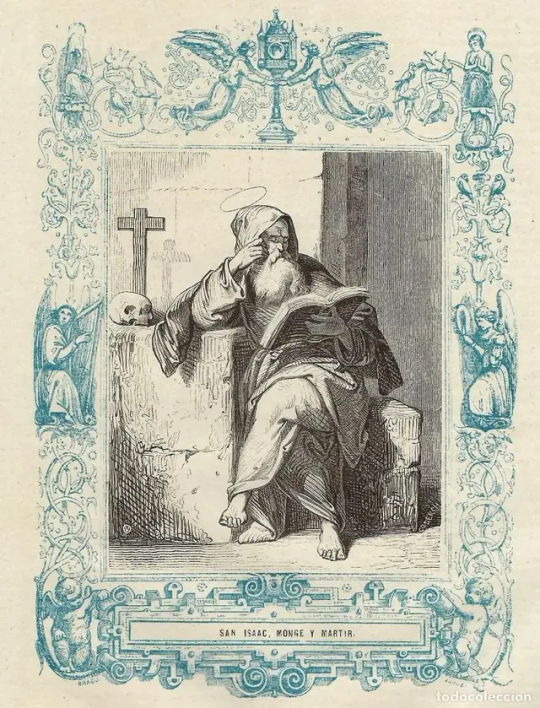
View On WordPress
0 notes
Text
SAN EULOGIO DE CÓRDOBA
SAN EULOGIO DE CÓRDOBA
SAN EULOGIO DE CÓRDOBA
SAN EULOGIO DE CÓRDOBA. Nació en Córdoba a comienzos del siglo IX y en esta ciudad ejerció su ministerio sacerdotal. Es el principal escritor de la Iglesia mozárabe, y uno de sus santos más importantes. Dada la difícil situación de la comunidad cristiana española por la dominación árabe, san Eulogio fue siempre consuelo y aliento para todos los perseguidos por su fe. Lo…

View On WordPress
0 notes
Text
9 de enero - San Julián / San Eulogio de Córdoba / Santa Lucrecia de Córdoba.
-Por San Julián, si lo ves, creció el día un sí es no es; por San Antonio, lleva un paso del demonio; por San Blas, tiene una hora más, y tira hasta San Matías, que empareja la noche con el día.
-San Julián, guarda vino y guarda pan.
-Por San Eulogio, las castañas al fuego, la leña al hogar y las ovejas a encerrar.
-San Julián, de buena estrena, buena comida y mejor cena.
-Entre San Eulogio y San Martino se coge la piña al pino.
- Anónimo
0 notes
Text
50 AÑOS DE CÁRCEL A SECUESTRADORES
Córdoba, Ver.– A 50 años de cárcel fueron sentenciados tres sujetos acusados de participar en el secuestro de una persona, ocurrido en pleno centro de la ciudad de Córdoba cuando salía de un bar.
Los plagiarios, que pasarán el resto de sus vidas tras las rejas, son Alfredo “N”, Crisantos “N” y Eulogio “N”, quienes privaron de su libertad a un hombre identificado solo con las iniciales DHGR.
De…
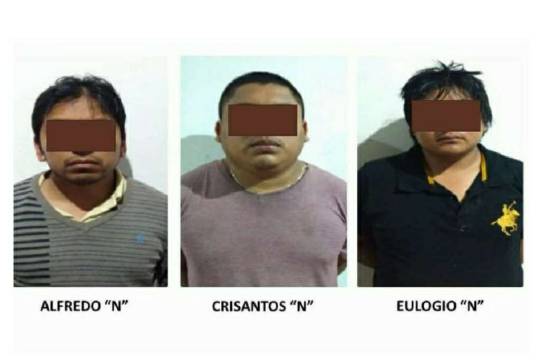
View On WordPress
0 notes
Text
Todos los Datos con Horarios e Itinerarios de la Procesión de la Virgen del Amparo de Córdoba
Todos los Datos con Horarios e Itinerarios de la Procesión de la Virgen del Amparo de Córdoba
La hermandad del Huerto celebrará este próximo martes 1 de noviembre la tradicional salida procesional de Nuestra Señora del Amparo. La cotitular de la corporación del Domingo de Ramos, tras los cultos que se realizarán ese mismo día, volverá así a recorrer las calles aledañas a la parroquia de San Francisco y San Eulogio en la festividad de Todos los Santos.
Tras el rezo del Ángelus, que tendrá…
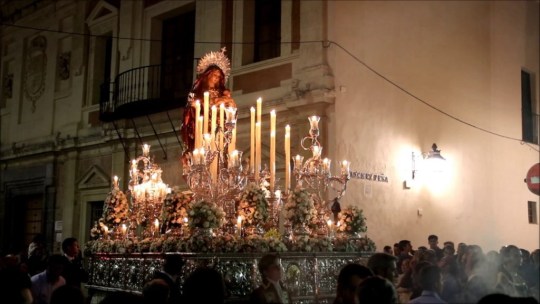
View On WordPress
0 notes
Photo

La plaza de San Nicolás o del Cementerio (existió uno allí) se llama así porque en ella se ubicó la Parroquia dedicada a San Nicolas de Bari y ampliándose posteriormente, por Decreto del obispo D. Fray Diego Mardones, el título a San Eulogio en 1642 A esta plaza afluye la Calle Badanas, llamada así por la ventad de pieles de este tipo. También existió una fábrica de paños y capotes. La plazuela tiene dos salidas más, una al paseo de La Ribera y la otra por la calle Consolación que desemboca en el cruce conocido momo de las Cinco Calles: Lineros, Don Rodrigo, Carlos Rubio, Mucho Trigo y la propia Consolación. #lamemoriapresente #fotografía #fotografiaartistica #foto #cordoba #córdoba #urbanismo #patrimoniodelahumanidad #historiadecordoba #spain #andalucia #travel #españa #photography #instagood #photooftheday #picoftheday #cordobaesp #travelphotography #art #beautiful #photo #travelgram #instatravel #cordobaespaña #architecture #andalusia #nature #mezquita #wanderlust https://www.instagram.com/p/Ch1uX0fq1WS/?igshid=NGJjMDIxMWI=
#lamemoriapresente#fotografía#fotografiaartistica#foto#cordoba#córdoba#urbanismo#patrimoniodelahumanidad#historiadecordoba#spain#andalucia#travel#españa#photography#instagood#photooftheday#picoftheday#cordobaesp#travelphotography#art#beautiful#photo#travelgram#instatravel#cordobaespaña#architecture#andalusia#nature#mezquita#wanderlust
0 notes
Photo
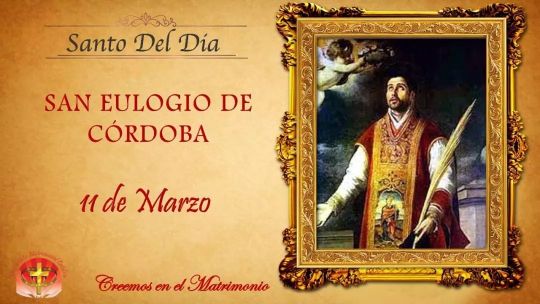
San Eulogio De Córdoba. https://www.instagram.com/p/Ca84oPRAT2a/?utm_medium=tumblr
0 notes
Photo

Santoral Marzo 1 ALBINO ROSENDO FELIX ANTONINA Efemerides Marzo 1 Primer Día del Año Mexicano 1492 De regreso de su primer viaje al Nuevo Mundo, Cristóbal Colón arriba a Lisboa, Portugal. 1517 Francisco Hernández de Córdoba arriba a isla Mujeres, con cuatro naves y una tripulación numerosa. A Hernández de Córdoba se le encomendó viajar a las Lucayas a rescatar o 'saltear' aborígenes para después venderlos en la isla, pero una fuerte tempestad los azotó y llevó al lugar que bautizaron con el nombre de Mujeres, por los ídolos de aspecto femenino que encontraron. 1521 Es coronado, sin ostentación, Cuauhtémoc, último emperador azteca. De acuerdo con la tradición, tuvo que casarse. Lo hizo con su prima Teucipoh. El mando lo había tomado desde el 9 de enero anterior. 1791 Nace en Cosamaloapan, Veracruz, Manuel Eulogio Carpio Hernández, médico, poeta y periodista. 1845 El Congreso de los Estados Unidos de América aprueba la anexión de Texas y fija como límite al sur, el río Bravo, situación arbitraria, ya que no abarcaba tanto el original territorio delimitado en su mexicanidad. 1854 Plan de Ayutla. El coronel Florencio Villarreal, en entendimiento con don Juan N. Álvarez y con don Ignacio Comonfort, proclama en Ayutla, Guerrero, el plan lanzado en contra del mal gobierno de Antonio López de Santa Anna. 1866 Con el general Andrés S. Viesca y los coroneles Francisco Naranjo y Jerónimo Treviño al frente, fuerzas republicanas arrasan con las tropas imperialistas acantonadas en la hacienda de Santa Isabel, cerca de Parras, Coahuila. https://www.instagram.com/p/CakaLaDpo5I/?utm_medium=tumblr
0 notes
Text
As I promised, let's start with the bookscans:
Al-ANDALUS. PERSONAJES HISTÓRICOS
(Al Andalus. Historical figures)
Concepción Masiá
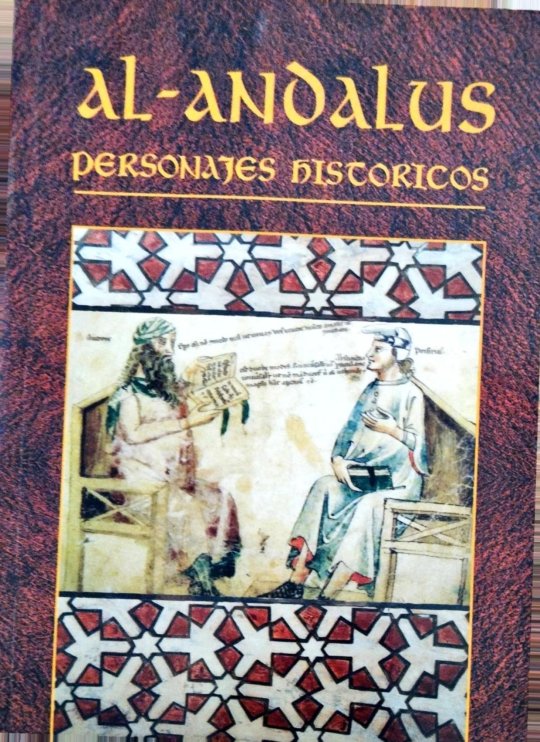
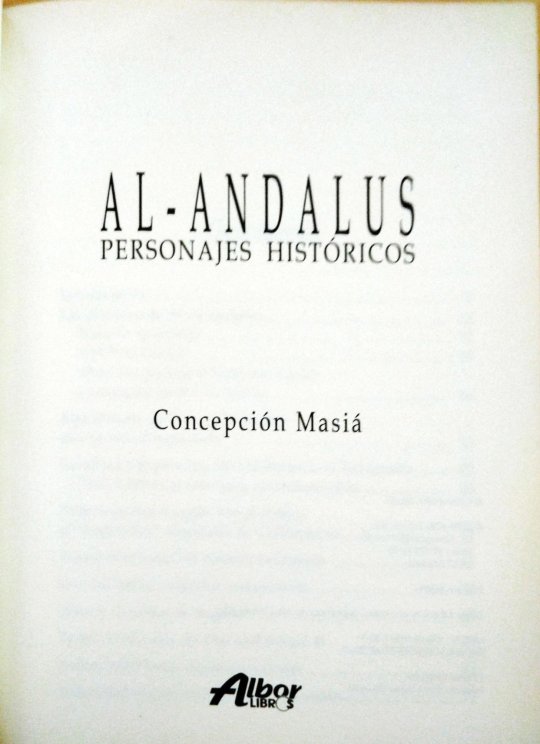

Summary
Introduction.................................. 9
The precursors of al-Andalus.....13
Count Don Julián....................13
Tarif ben Malluk. ....................15
Musa ben Nusayr and Tariq ben Ziyad: the conquerors of Spania...........16
Abd al-Aziz: a good governor with an unfortunate fate ..........................25
The Odyssey of Prince Abd al-Rahman the Immigrant......................................29
Abd al-Rahman was only twenty-five years old.........................................36
Sulayman ben Yaqzan ben al-Arabi: Charlemagne's deceived "deceiver" ........................... ...........41
Amrus ben Yusuf: the muladí of Huesca
.............................................................47
The “rabadies”: adventurous spirits.. ..............................................53
Ziryab: the singer of Baghdad........61
Tarub: the favorite of Abd al-Rahman II...............,...........................................67
Abbas ben Firnas: the first aviator............................ ......................73
Yahya ben Hakan al-Bakri: the miserly poet.....................................................77

Abd al Chabbar and Sulayman ben Martin: the rebels of Mérida..........................81
Eulogio and Álvaro de Córdoba:
pursuing martyrdom..........................85
The Andalusian Vikings..................... 95
The emir Abd Allah distrust and death...............................….................... 101
Musa ben Musa ben Qasi: the third king of Spain.......................................................107
Ibn Hafsun: the unredeemed rebel.....115
Abu Alí al-Sarrach: the Andalusian missionary. ...........................................125
Ibn Masarra: a freethinker in Spanish Islam.......,...........,...................................131
Abd al-Rahman III:
the first independent caliph of al-Andalus. ...........,................................137
Hasday ibn Shaprut:
the Jewish doctor of Abd al-Rahman III............ ....... ...................... ................... 145
Andalusians in France: the “Moorish kingdom” of Fraxinetum....................... 151
Rabbi ben Zayd: Bishop Recemundo............................................. 157
Al-Hakam al-Mustansir bi-llah:
passion for culture.................................. 161
Ibn Abd Rabbhi, the encyclopedist,
and Ibn Futais, the collector.................. 167
Al-Mansur “the Victorious” ...................171
Hisham II and Sanchuelo: misrule. .......191
Abu Muhammad Ali ibn Hazm:
The pigeon neackle................................209
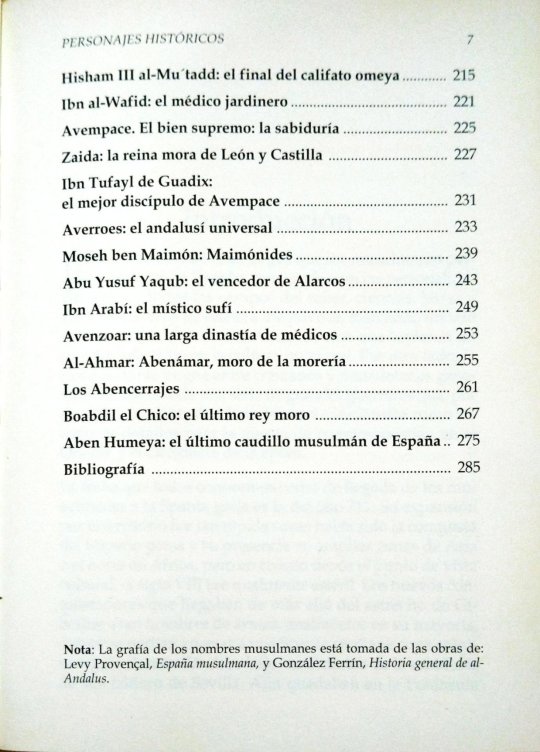
Hisham III al-Mu'tadd: the end of the Umayyad caliphate...............................215
Ibn al-Wafid: the gardener doctor.....221
Avempace. The supreme good: wisdom...................................................225
Zaida: the Moorish Queen of Leon and Castile........................................................227
Ibn Tufayl of Guadix:
the best disciple of Avempace................. ............................ .231
Averroes: the universal Andalusian....233
Moseh ben Maimon: Maimonides..... ..239
Abu Yusuf Yaqub: the winner of Alarcos......................................................243
Ibn Arabi: the Sufi mystic.....................249
Avenzoar: a long dynasty of doctors. ...................................................253
Al-Ahmar: Abenámar, Moor of the Morería. ...,...............................................255
The Abencerrajes. ..................................261
Boabdil the Younger: the last Moorish king ............................................................267
Aben Humeya: the last Muslim leader of Spain................ ..........................................275
Bibliography .............................................285
Note: The spelling of Muslim names is taken from the works of: Levy Provençal,
Muslim Spain, and González Ferrín, General History of al-Andalus.

Introduction
In the long eight hundred years that the Muslims remained in Spain, there were many personalities who, in all the fields of knowledge, sciences, letters and arts, stood out unequivocal, marking a milestone not only in the culture of al-Andalus, but that had a relevant character in universal culture.
On the other hand, the almost constant struggle between Christians and Muslims would also generate a whole series of great warriors who, for example, the infante Don Juan Manuel considered the best gifted for the war of all those who existed in the East and the West of their time.
The date that we all know as the arrival of the Muslims to Gothic Spania dates back to the year 711. Its expansion throughout the territory was so rapid as had been the conquest of the Persian empire and its presencein large areas of Asia or North Africa, but from a cultural point of view, the 8th century was totally sterile. The new conquerors who arrived from beyond the Strait of Gibraltar, were men at arms, mostly illiterate, who could do little contribute to a Christian Spania whose culture continued to develop under the dictates of the wisdom of Saint Isidore of Seville. Still they were left on the Peninsula
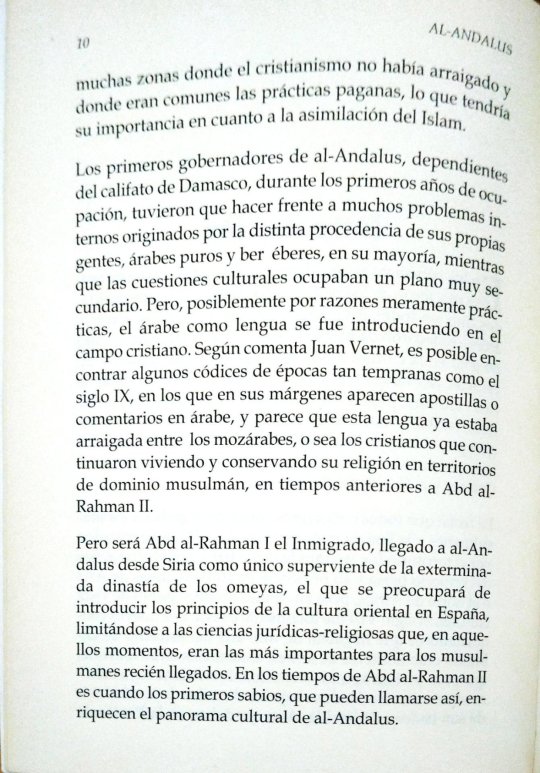
many areas where Christianity had not taken root and its importance regarding the assimilation of Islam.
The first governors of al-Andalus, dependent on Caliphate of Damascus, during the first years of occupation
had to face many enormous internal problems, originated by the different origins of their own people, Arabs
and berebers, mostly, while cultural issues occupied a very secondary level. But, possibly for purely practical reasons, Arabic as a language was introduced into the Christian field. According to Juan Vernet, it is possible to find
some codices from times as early as the 9th century, that in its margins appear apostilles or comments in Arabic,
and it seems that this language was already rooted among the Mozarabs,
that is, the Christians who continued to live and preserve their religion in Muslim-dominated territories, in times
before Abd al-Rahman II.
But it will be Abd al-Rahman I the Immigrant, who arrived in al-Andalus from Syria as the only survivor of the exterminated Umayyad dynasty, the one who will be concerned with introducing the principles of oriental culture in
Spain, limiting itself to the legal-religious sciences that, in those moments, were the most important for the newly Muslims
arrived. It was during the time of Abd al-Rahman II that the first wise men, who can be called that, enrich the cultural landscape of al-Andalus.

Poets, doctors, philosophers, mathematicians, geographers, undefeated generals...All of them will give al-Andalus and Europe a series of works that, by their importance will be translated, searched, accepted and will serve as a basis for the western culture and Renaissance ideas, in such a way that many of the great sages of the Italian Renaissance considered that all knowledge of the time came from Muslim Spain, which all the wise men were of Andalusian origin. And when the political decline and the disintegration of the caliphate, will not stop birth, grow and develop distinguished minds that will continue to maintain,for a long time, the prestige of al-Andalus. Curiously, this situation will be repeated throughout the history of Spain, when the Arab occupation just be a memory. The Spanish Golden Age will coincide with decadence of the Austrias, when the country loses its pre-ponderance in Europe, and with the disaster of '98, with the loss for Spain of its last colonies, will produce a cultural and scientific renaissance that has been called the Silver age.
Through the pages of this book we want to highlight those figures who occupied a predominant place in the history of al-Andalus, although not all of them were necessarily Muslims, since that in that cultured and tolerant al-Andalus, many Jews and some other Christians showed their genius, and of those who, often, we know more about his works than about his biography. But whatever religion they had, they were all, after all, Andalusians, born and raised in the extensive lands of al-Andalus. As a matter of curiosity we will include some groups of characters
anonymous people who, due to their surprising
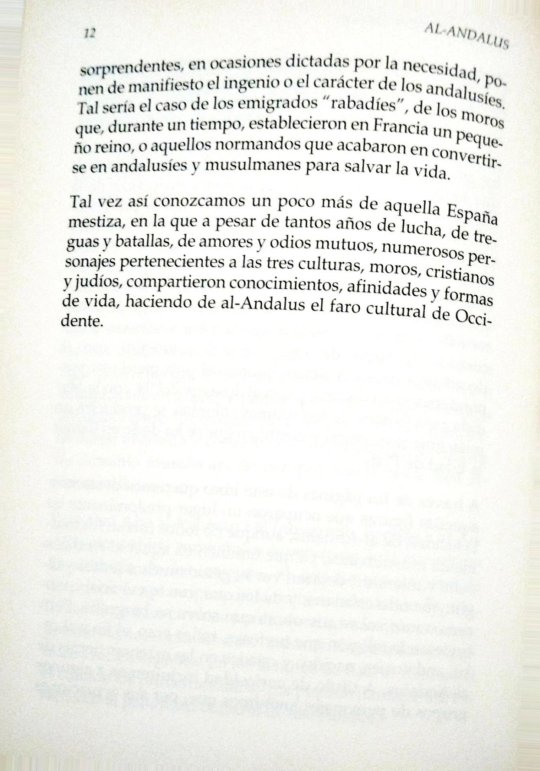
actions, on occasions dictated by necessity, they reveal the ingenuity or character of the Andalusians. Such would be the case of the "rabadíes", of the Moors who, for a time, established a small kingdom in France, or those Normans who ended up becoming Andalusians and Muslims to save their lives.
Perhaps this way we will learn a little more about that crossbred Spain, in which despite so many years of struggle, truces and battles, mutual loves and hates, numerous characters belonging to the three cultures, Moors, Christians and Jews shared knowledge, affinities and forms of
life, making al-Andalus the cultural beacon of the West.

The precursors of al-Andalus
Count Don Julián
The conquest of Morocco had been carried out quickly, but shallow. The Berbers were only subdued after a fierce resistance, defeated by an ambitious general who had just been appointed governor of Ifriqiya and Maghrib. His successes in these lands
They would prepare the ground for him to be the one to set his eyes and, also
his troops, over Gothic Spania. It was Musa ben Nusayr.
Musa, with the help of one of his sons, took possession of Tangier, and demanded that the subjugated tribes hostage to educate them in the new faith, which in turn, became propagandists of Islam, leaving in the conquered Morocco
Arab lieutenants, including General Tariq ben Ziyad, he turned to Ifriqiya. But it seems that the Ceuta square remained
in the hands of a Christian, the so-called Count Don Julián, who would have a
determining role in this entire story. We could consider it as a precursor of that al-Andalus that was about to be born.
#bookblr#book scans#historyblr#history books#al andalus#al andalus. personajes históricos#al andalus. historical figures#history#spanish history#musa ibn nusayr#tariq ibn ziyad#conde don julián#count don julián#count julian
27 notes
·
View notes
Text
Obras completas de San Eulogio de Córdoba - Libro
San Eulogio de Córdoba es una figura clave dentro del breve florecimiento de las letras latinas que tuvo lugar en la Córdoba de mediados del siglo IX, en medio de un progresivo proceso de islamización de la sociedad. Su obra está centrada casi por completo en el célebre conflicto de los llamados «mártires voluntarios». de esa manera, en una prosa tan apasionada como alambicada, el autor se…
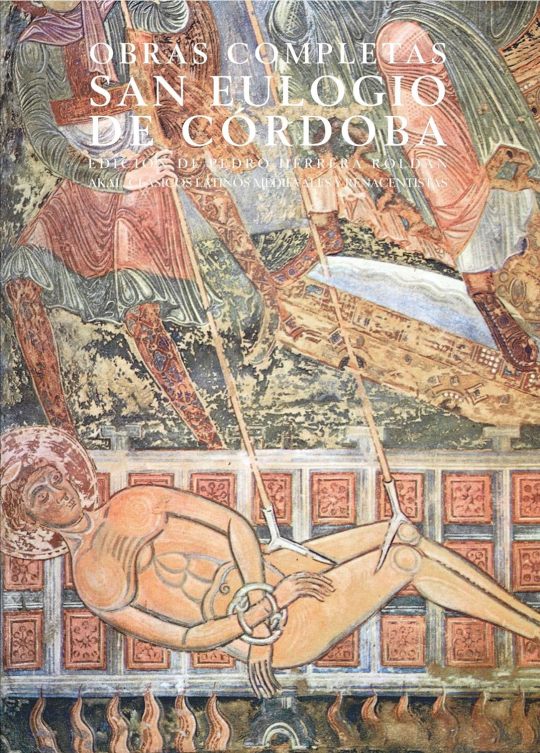
View On WordPress
1 note
·
View note
Text
SANTA NUNILO Y SANTA ALODIA
SANTA NUNILO Y SANTA ALODIA
SANTA NUNILO Y SANTA ALODIA.
SANTA NUNILO Y SANTA ALODIA. La historia de estas dos hermanas nos la refiere, sobre todo, san Eulogio de Córdoba. Nacieron en Adahuesca, provincia de Huesca en España, entre los años 824 y 827. Su padre era musulmán y su madre cristiana. El padre murió pronto y la madre las educó en el cristianismo. También la madre murió prematuramente y las hijas fueron a vivir…

View On WordPress
0 notes
Text
youtube
Watch the American Climate Leadership Awards 2024 now: https://youtu.be/bWiW4Rp8vF0?feature=shared
The American Climate Leadership Awards 2024 broadcast recording is now available on ecoAmerica's YouTube channel for viewers to be inspired by active climate leaders. Watch to find out which finalist received the $50,000 grand prize! Hosted by Vanessa Hauc and featuring Bill McKibben and Katharine Hayhoe!
#ACLA24#ACLA24Leaders#youtube#youtube video#climate leaders#climate solutions#climate action#climate and environment#climate#climate change#climate and health#climate blog#climate justice#climate news#weather and climate#environmental news#environment#environmental awareness#environment and health#environmental#environmental issues#environmental justice#environment protection#environmental health#Youtube
16K notes
·
View notes
Photo
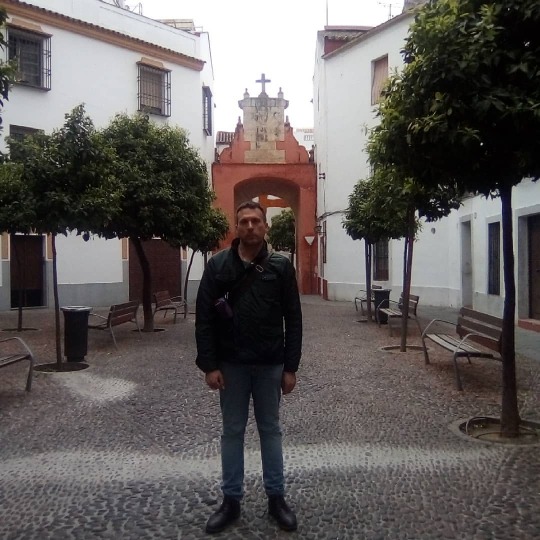
De ruta eclesiástica cofrade por Córdoba (en Parroquia San Francisco y San Eulogio) https://www.instagram.com/p/B9M72XYCabV/?igshid=103k4v0g32anu
0 notes
Photo
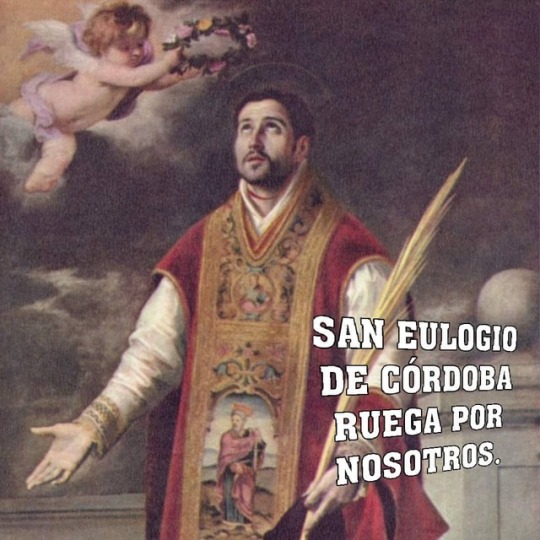
DÍA 11 DE MARZO SAN EULOGIO DE CÓRDOBA. Nació en Córdoba a comienzos del siglo IX y en esta ciudad ejerció su ministerio sacerdotal. Es el principal escritor de la Iglesia mozárabe, y uno de sus santos más importantes. Dada la difícil situación de la comunidad cristiana española por la dominación árabe, san Eulogio fue siempre consuelo y aliento para todos los perseguidos por su fe. Lo decapitaron, por vivir y confesar públicamente la fe cristiana, el 11 de marzo del año 859, cuando había sido preconizado arzobispo de Toledo; en España su fiesta se celebra el 9 de enero. Oración: Señor y Dios nuestro: tú que, en la difícil situación de la Iglesia mozárabe, suscitaste en san Eulogio un espíritu heroico para la confesión intrépida de la fe, concédenos superar con gozo y energía, fortalecidos por ese mismo espíritu, todas nuestras situaciones adversas. Por Jesucristo, nuestro Señor. Amén. ♡♡♡♡♡♡♡♡♡ #catolico #catolicosoy #catolicosporamor #católicos #jovenscatolicos #catolicospelomundo #catolicosypunto #catolicosenacción #somoscatolicos #iglesiacatolica #papafrancisco #dios #catolicosiempre #catolicosunidos #latinoamericacatolica #iglesia #solodiosbasta #catolicosdelmundo #yosoymariano #preciosasangredecristo #divinamisericordia #jesusenticonfio #renovacioncarismatica #sagradocorazon #virgenmaria #santorosario #espiritusanto #rezaelrosario #yavieneyareina #mariamirame2018 https://www.instagram.com/p/Bu2KPMqnJ3N/?utm_source=ig_tumblr_share&igshid=13xpqvhxl1o2j
#catolico#catolicosoy#catolicosporamor#católicos#jovenscatolicos#catolicospelomundo#catolicosypunto#catolicosenacción#somoscatolicos#iglesiacatolica#papafrancisco#dios#catolicosiempre#catolicosunidos#latinoamericacatolica#iglesia#solodiosbasta#catolicosdelmundo#yosoymariano#preciosasangredecristo#divinamisericordia#jesusenticonfio#renovacioncarismatica#sagradocorazon#virgenmaria#santorosario#espiritusanto#rezaelrosario#yavieneyareina#mariamirame2018
0 notes
Text
Todos los datos de la Procesión de La Virgen del Amparo. Córdoba 01 de Noviembre del 2022
Todos los datos de la Procesión de La Virgen del Amparo. Córdoba 01 de Noviembre del 2022
La Hermandad del Huerto celebrará el 1 de Noviembre (Martes), desde la Parroquia de San Francisco y San Eulogio (Compás de San Francisco), una Salida Procesional presidida por la Imagen de Nuestra Señora del Amparo, a partir de las 18:00h (tras una Eucaristía a las 17h).
El recorrido de la Salida Procesional con Nuestra Señora del Amparo, que va a contar con el acompañamiento de la Banda de…

View On WordPress
0 notes
Photo

Día litúrgico: 13 de Junio del 2,021. Domingo de la Décima Primera Semana del Tiempo Ordinario Ciclo (B) #SANTODELDÍA San Antonio de Padua, San Fandila de Córdoba, Santa Aquilina virgen y mártir, San Aventino mártir, San Ceteo de Amiterno, San Eulogio de Alejandría, Santa Felícula, San Trifilio, Beato Aquíleo de Alejandría, Beata María Ana Biernacka Aleluya, aleluya. La semilla es la palabra de Dios y el sembrador es Cristo; todo aquel que lo encuentra vivirá para siempre. Aleluya. † Lectura del Evangelio de Nuestro Señor Jesucristo Según San Marcos (4,26-34) Gloria a ti, Señor. En aquel tiempo, Jesús decía a la gente: «El Reino de Dios es como un hombre que echa el grano en la tierra; duerma o se levante, de noche o de día, el grano brota y crece, sin que él sepa cómo. La tierra da el fruto por sí misma; primero hierba, luego espiga, después trigo abundante en la espiga. Y cuando el fruto lo admite, en seguida se le mete la hoz, porque ha llegado la siega». Decía también: «¿Con qué compararemos el Reino de Dios o con qué parábola lo expondremos? Es como un grano de mostaza que, cuando se siembra en la tierra, es más pequeña que cualquier semilla que se siembra en la tierra; pero una vez sembrada, crece y se hace mayor que todas las hortalizas y echa ramas tan grandes que las aves del cielo anidan a su sombra». Y les anunciaba la Palabra con muchas parábolas como éstas, según podían entenderle; no les hablaba sin parábolas; pero a sus propios discípulos se lo explicaba todo en privado. PALABRA DEL SEÑOR. GLORIA A TI, SEÑOR JESÚS. REFLEXIÓN DEL EVANGELIO «El Reino de Dios es como un hombre que echa el grano en la tierra» Fr. Faust BAILO (Toronto, Canadá) Hoy, Jesús nos ofrece dos imágenes de gran intensidad espiritual: la parábola del crecimiento de la semilla y la parábola del grano de mostaza. Son imágenes de la vida ordinaria que resultaban familiares a los hombres y mujeres que le escuchan, acostumbrados como estaban a sembrar, regar y cosechar. Jesús utiliza algo que les era conocido —la agricultura— para ilustrarles sobre algo que no les era tan conocido: el Reino de Dios. https://www.instagram.com/p/CQFK_qCD2CG/?utm_medium=tumblr
0 notes
Text
youtube
Watch the 2024 American Climate Leadership Awards for High School Students now: https://youtu.be/5C-bb9PoRLc
The recording is now available on ecoAmerica's YouTube channel for viewers to be inspired by student climate leaders! Join Aishah-Nyeta Brown & Jerome Foster II and be inspired by student climate leaders as we recognize the High School Student finalists. Watch now to find out which student received the $25,000 grand prize and top recognition!
#ACLA24#ACLA24HighSchoolStudents#youtube#youtube video#climate leaders#climate solutions#climate action#climate and environment#climate#climate change#climate and health#climate blog#climate justice#climate news#weather and climate#environmental news#environment#environmental awareness#environment and health#environmental#environmental issues#environmental education#environmental justice#environmental protection#environmental health#high school students#high school#youth#youth of america#school
16K notes
·
View notes